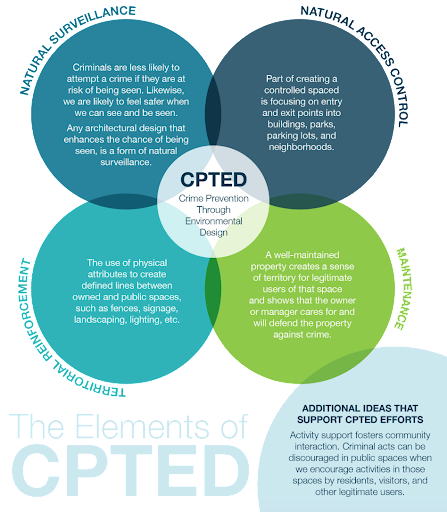ORS: Documents-Research Briefs-CPTED (In Brief)
In Brief:
Crime Prevention Through Environmental Design (CPTED)
An overview for public safety professionals
Mindy Duong, Statistical Analyst, Office of Research & Statistic (February 2024)
PDF Version- In Brief: Crime Prevention Through Environmental Design (CPTED)
HTML Version- In Detail: Crime Prevention Through Environmental Design (CPTED)
PDF Version- In Detail: Crime Prevention Through Environmental Design (CPTED)
Crime Prevention Through Environmental Design (CPTED) has been utilized in law enforcement practices and city design for decades. The basic principles of CPTED are that the environment impacts crime, both as cause and prevention, and effective implementation requires a collaborative effort from law enforcement agencies and community partners, such as business owners and the general public (Dudley, 2019 & Weyand, 2022).
Effective CPTED strategies and implementation have been shown to reduce crime and call for service, sometimes by more than 60%, and improve public safety (Cozens & Love, 2015 & Dudley, 2019). Effectiveness can be measured quantitatively by examining the total crimes and calls for service, and qualitatively by the overall sense of security felt by the community and their natural participation in helping maintain and monitor properties and shared spaces.
CPTED Strategies for Officers
- Regular contact with business owners to foster strong relationships and encourage accountability and compliance with CPTED best practices on deterring crimes and delinquent behaviors.
- Detail environmental concerns in police reports such as low lighting or ineffective access control to help support future research on CPTED best practices and implementations.
- Increase community outreach and community-led policing efforts, including regular attendance at town hall meetings and other community events to educate the public on CPTED strategies.
- Encourage gatherings in public spaces to deter crime as locations with frequent foot traffic discourage opportunistic offenders as there are many “eyes on the street” (Cozens & Love, 2015). Proximity to green spaces (e.g., parks) has been linked to crime reduction (Larson, 2019).
Additional Information & Resources
- Crime Prevention Through Environmental Design in Parker, CO
(Source of the image above. See embedded image content in Appendix A below.) - International CPTED Association’s Quarterly Newsletters
- National Crime Prevention Council’s CPTED Guidebook (pdf)
- Safer Streets Grant Program’s Resources for Crime Prevention
References
Cozens, P., & Love, T. (2015). A Review and Current Status of CPTED. Journal of Planning Literature, Volume 30(4), 392-412. DOI: 10.1177/0885412215595440
Dudley, J. (2019). 6 Reasons Why CPTED Should Be Part of Every Agency's Crime-fighting Plan. Police1.Com.
Larson, L., & Ogletree, S. (2019). Can parks help cities fight crime? TheConversation.Com.
Weyand, O. (2022). Crime Prevention through Environmental Design in Parker, CO. ArcGIS StoryMaps.
APPENDIX A
(The following is the entirety of the content embedded in the CPTED image above.)
The Elements of CPTED: Crime Prevention Through Environmental Design
- Natural Surveillance. Criminals are less likely to attempt a crime if they are at risk of being seen. Likewise, we are likely to feel safer when we can see and be seen. Any architectural design that enhances the chance of being seen is a form of natural surveillance.
- Natural Access Control. Part of creating a controlled space is focusing on entry and exit points into buildings, parks, parking lots, and neighborhoods.
- Territorial Reinforcement. The use of physical attributes to create defined lines between owned and public spaces, such as fences, signage, landscaping, lighting, etc.
- Maintenance. A well-maintained property creates a sense of territory for legitimate users of that space and shows that the owner or manager cares for and will defend the property against crime.
- Additional Ideas that Support CPTED Efforts. Activity support fosters community interaction. Criminal acts can be discouraged in public spaces when we encourage activities in those spaces by residents, visitors, and other legitimate users.
If you have questions or accommodation requests, please visit the Office of Research & Statistics Request page.
